Cadence
[Equine Gaits] The regular rhythm of a horse's stride.
Cadre Noir (in English Black Cadre)

|
[Military] The Cadre Noir the traditional name given to instructors, at the French military riding academy because of the black uniforms that they wore. In modern times they are a team of elite civilian or military riders that compete in high level dressage, combined training and show jumping completions. Unlike Austria's Spanish Riding School they use various breeds of horses, including Lusitano and Selle Français horses.
Calf Roping
[Rodeo] Calf roping is a rodeo competition during which the horses ability is judged when the rider ropes, throws and hogties a calf.
Calgary Stampede
[Rodeo] The Calgary Stampede is a major rodeo held annually in July in Calgary, Canada.
Calling a Dressage Test
[Dressage] During a dressage test an individual on the edge of the arena can read out the elements of the test, indicating the called for transitions and the point that they are done in real time. This allows the rider to focus on the riding rather than try to remember the test pattern.
Camarillo White Horse
[Equine Breed] Camorillos are a very rare breed of pure white horse, which are a result of a genetic mutation. Most horses that appear to us as white are actually older gray horses, whose coloration has faded to white. The Camarillo White Horse is born with a white coat and has pink skin. Their muzzles are pink and subject to sunburn. The "W" gene is a dominant gene and will always be expressed when present. All Camorillos are heterozygous (Ww) with one copy of the mutated gene and one copy of the native gene at that locus. When an individual animal is conceived with two copies of the "W" gene (homozygous WW) the mutation is lethal and foal does not survive. Almost all animal species have rare Albino individuals but there is debated if this same kind of common albinism occurs in horses.
Camarque Horse
[Equine Breed] Camarques are a breed of horses native to the marshlands of the French Rhône delta where they survived as a wild breed for centuries. Camargues are always grey and like other grays begin life with a blue or dark gray coat color. They are small, strong, rugged and intelligent with a short neck, deep chest, compact body and a full mane and tail.
Camped Out
[Equine Behavior] A horse is said to be camped out when it stands with its forelimbs stretched forward and hindlimbs stretched posterior. Male horses exhibit this when urinating. Some are trained to do this when being judged for confirmation. It also can be a sign of abdominal discomfort.
Camped Under

|
[Equine Behavior] A horse is said to be camped under when it stands with all limbs drawn under the body in an odd way. It can be a sign of pain.
Canine Teeth
[Equine Anatomy] Canine teeth are a set of four sharp teeth that commonly erupt around age four. They are generally found in male horses and are located behind the incisors and in front of the cheek teeth. The are used a weapons in male dominance competitions.
Canker
[Veterinary Medicine] Canker is a mixed bacterial infection of the frogs of hooves in horses and characterized by black or brown, foul-smelling, cauliflower-like growths. Wet conditions, manure on the ground and poor hoof care contribute. The feet can become sore and in extreme cases the horse can become lame. Treatment includes surgical debridement, antibacterial solutions, antifungal creams, and dressings to keep the area clean and dry.
Cannon Bone
[Equine Anatomy] The cannon bone (proximal phalanx) is a lower leg bone that stretches from the knee joint to the fetlock joint. It is interesting how what is a smallish finger or toe bone in a human can be a large and important bone in a horse.
Canter
[Equestrian Gait] A natural 3-beat gait that is faster than a trot or pace but slower than a gallop. A canter can be undertaken on a right or a left lead, which describes the inside foreleg that the horse advances initially when going into the gait. When learning to ride one's first canter is always a thrilling moment and maybe a little scary as well. The aid used to signal the horse by the rider is a gentle tug on the outside rein and reaching a little backward with the inside leg and exerting pressure against the horse's side. Horses will also learn and respond to the word "canter." The rider can also use aids to slow or quicken the speed of the canter.
Cantle
[Equine Equipage] The cantle is raised back section of the saddle's seat that serves to provide a backrest and support for the rider. Its function is to keep the rider forward in the saddle's seat. The medieval jousting saddle had particularly high cantle.
Capped Hock (Pseudobursitis of the Hock)
[Veterinary Medicine] A capped hock is the result of trauma to the point of the hock (tuber calcaneous). It appears as a swelling in the posterior region of the hock, occasionally associated with lameness. It is referred to as a pseudobursitis because it is not a true inflammatory condition. It generally resolves over time.
Capping
[Fox Chasing] Capping is a term for the moment when the hounds catch up to the fox.
Capping Fee
[Fox Chasing] A capping fee is a fee paid by non-members for the privilege of riding with a hunt.
Capriole
[Classical Dressage] A capriole is a vertical leap with a backward kick of the hind legs at the height of the leap. It is one of the "airs above the ground" that can be seen at demonstrations of the Spanish Riding School of Vienna. The movement was originally developed for military use and allowed a cavalryman to cause his horse to kick out at an enemy coming up from behind him. A perfectly executed capriole is difficult for the animal to learn and is indicative of a high level of training.
Carbine
[Cavalry Equipage] A carbine is a shortened version of a standard military rifle, originally intended for mounted units.
Carriage
[Equine Attribute] The carriage of a horse is the manner in which it carries itself. Its movement should be graceful with head held high and an alert expression.
Carriage
[Driving] A carriage is a class of wheeled, either open or closed, passenger vehicles, pulled by one or more horses. Within the class there are specific names for each style of vehicle.
Carry a Line
[Fox Chasing] The act of a pack of fox hounds following a scent trial, which is referred to as a line.
Cart
[Driving] A cart is a class of small, two wheeled, passenger or haulage vehicles, pulled by one horse.
Carted (British Slang Usage)
[Equine Behavior] A rider is said to have been carted when his horse runs away with him.
Caspian
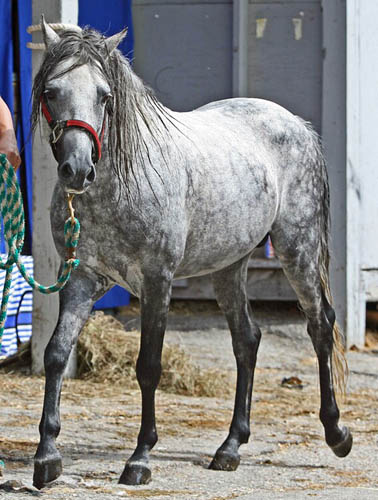
|
[Horse Breed] Caspians are an ancient, small statured breed native to the mountainous regions of northern Iran. they are considered the be hardy, tough, athletic, nimble and have strong hooves. Their numbers remain relatively small.
Cast
[Equine Emergency] A cast horse is on the ground and is unable to stand. This often occurs when the animal is in a stall with its legs pinned against a wall or partition. Often the animal will panic and thrash around. You should remain calm, summon help (even if only to observe you for safety), attempt to calm the horse all while avoiding injuries to yourself, which is a real possibility. Once the horse is calmer work on the front end by pulling on the mane toward the center of the neck and attempt to get the horse's front legs free. Be prepared to move out of his way if he attempts to get back on his feet. It is said you should not pull on a halter, which can cause neck injuries. The rear end may be moved out by cautiously pulling on the tail. You should consider phoning your veterinarian, local animal control or first responders for advice and aid. It is better to wait and have adequate help than be injured while trying to do it yourself. I have never had to contend with this in a stall but have had a horse slip on wet ground and slide partly under a fence. Interestingly, this happened at night and the other horses made a lot of noise which attracted our attention to the situation.
Cast
[Fox Chasing] The act of a pack of fox hounds spreading out with noses to the ground, searching for the scent of a fox. A huntsman may direct this if he finds a likely spot or the hounds may act on their own.
Cast

|
[Horse Management] The term cast is also used in situations where a horse is deliberately thrown to the ground in order to preform a procedure. In a time before good anesthetics were available, handbooks were filled with illustrations how to rig a horse to accomplish this. There are risks possible with deliberately casting a horse and also leaving a horse flat on its side or on its back (dorsal recumbency position) for a long time period. I suspect this is very rarely, if ever done now.
Cat Leap
[Equestrian Jumping] A cat leap is a situation when a horse halts before a jump and then pops over the jump. The rider is at risk of becoming off balance and falling off and it is not anything desired. I imagine that most jumpers at some point have experienced a couple of these. It reminds you of just how much power these animals have under their hoods. I witnessed the last cat leap my wife had when on wet ground the horse skidded at the takeoff point, halted, and then cat leapt over. My wife lost her balance and was falling, only the grab around the horse's neck and vault to her feet. I wish I had it on on tape.
Caulk
[Equine Equipage] Caulks are small studs screwed into certain horse shoes that function similarly to cleats on frozen ground..
Cavalcade
[Horse Parade] A cavalcade is a procession or parade by a large number of people on horseback. The original meaning had been expanded to mean a procession of various things other than horses. The young Queen Victoria was very fond of organizing grand royal cavalcades in England.
Cavaletti (Bodenrick-German)
[Schooling] A 9 foot, single pole with either square blocks or or enclosed X-shaped supports at either end, holding it slightly off the ground and used in schooling movement or jumping. They are generally employed in spaced groups on the ground or stacked on each other to form a jump. Some experts advise against the latter practice as when they collapse they can fall in unpredictable ways and cause injuries. Ground schooling with cavaletti also requires some care since green horses regularly stumble over them.
Cavesson
[Equine Equipage] A Cavesson is a bitless headgear for horses, commonly used when longeing. The noseband is padded and there are extra rings for attaching lines to. In many ways in this otherwise similar to a halter.
Center Line
[Dressage] The center line is an unmarked (therefore imaginary) line running down the middle of a dressage ring between the marked points of "A" and "C" on the ring's rail. The rider needs to keep the position of this line in mind since it is the point of various transitions during the test. Riders loses marks if their transitions fail to occur exactly at the center line. The judges are seated in line with this imaginary line and thus have no problem deciding if the rider was precise in the execution of the transition. Experienced dressage riders make it look so easy, but it is fair to say dressage is much more difficult than most causal observers realize.
Chain Drag Harrow
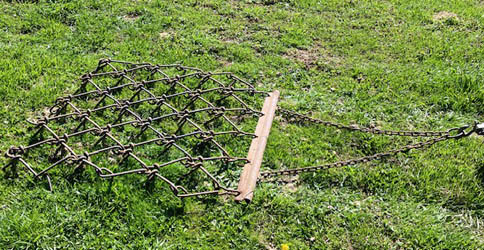
|
[Pasture Management] A chain drag harrow is an agricultural tool that is made to be towed behind a tractor and has the function of breaking up clumps of horse dung in a field. They are usually employed in the spring and can be handled by one person and rolled up and stored in the barn until the next year. They consist of a series of links with thick prongs that stick down toward the soil.
Chaise
[Driving] A chaise is type of light, open carriage, generally intended for one-horse and two persons. It should not be confused with a post chaise, which is larger and a four-wheeled, closed coach for passengers and mail.
Champing
[Equine Behavior] Champing is a behavior commonly observed in young horses in response to the prospect they might be bullied by a dominant member of the herd. The foal will lower and extend his head and neck and make smacking and chewing movement with the lips are pulled back. The behavior is indicative of submission or appeasement. "I am just a baby leave me alone." This same behavior is observed after an adult horse is trained with Monty Robert's Joint Up procedure. In that situation the horse is indicating it accepts the dominance of the trainer.
Change of Rein
[Equitation] A change of rein occurs when a rider reverses the direction of movement in a ring, going from counterclockwise to clockwise or vice vera. This is important in order to balance the work between the horse's two sides.
Chaps
[Accessory Riding Clothing] Chaps are leather leggings worn over pants or britches to protect them from thorns and other sharp objects while trail riding. Although strongly identified with Western riding, they are used then needed as informal wear by English riders. I can attest when trail ridding in warm weather, wearing light weight clothing, I have had them get all torn up by thorns. The times I have worn chaps, I felt their rougher surface allowed for more grip on the saddle. In addition to full chaps, covering the entire leg, there are half chaps that serve only the lower leg.
Charreadas (Mexican Rodeo)
[Equestrian competition] Charreadas is a Mexican event comparable to American rodeo. There tends to be more music and cultural pageantry, including costuming, incorporated into charreadas. Charreadas feature both male and female events.
Charro (Spanish for a rustic)
[Rider Terminology] A horseman riding in traditional Mexican equestrian events.
Check
[Fox Chasing] A check occurs when the hounds lose the scent (can no longer follow the line). This might happen when the fox runs across a flowing stream, for example. The riders halt and wait quietly while the pack attempts to reacquire the scent.
Check Ligament (Accessory Ligaments)
[Equine Anatomy] Check ligaments connects a tendon to a bone in a way that no muscular contraction is required to hold it in place. They are part of the stay apparatus that among other things allow horse to experience light sleep standing up and also they prevent excessive lengthening of the tendons during movement. The two check ligaments are the superior check ligament and the inferior check ligament. They are subject to injuries.
Check Rein (Bearing Rein or Overcheck)
[Driving Tack] A check rein is a short leather strap that runs between the bit and the harness' saddle. Its sole purpose is to keep the horse from lowering its head while being driven in harness. It is the reason that carriage horses have that elegant tuck to their heads. They are also other practical rationales for their use. For example, they keep the horse from trying to graze while in harness, etc. Their use is optional, but also somewhat controversial. Problems can occur if they are adjusted too tight with respect to the horse's comfort, forcing it into an unnatural stance and interfering with its ability to breath and swallow easily.
Cheek Arm Extension
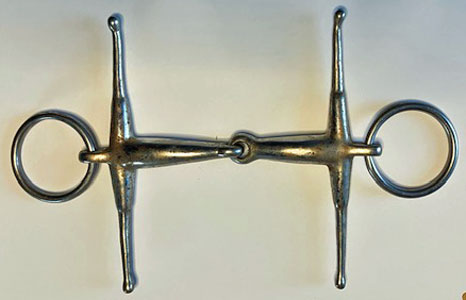
|
[Equestrian Tack] A cheek arm is a feature of certain snaffle bits that prevents the rings of the bit from sliding through the horse's month. It comes in two forms: a full cheek with an arm above and below the ring and a half cheek with an arm below only. The full cheek type should always be used with bit keepers, small leather loops that connect from the top portion of the bit’s cheek piece to the bridle, holding the bit in place. This type of bit puts pressure across the sides of the horse’s mouth giving excellent lateral control and aiding in steering, while putting less on the horse's sensitive lips and tongue.
Chef d’Équipe (Team Captain or Director)
[Equestrian Competition] The chef d’équipe manages an equestrian team in high level competition. The term is French and means chief of the team. Titles sounds so much more important when in French.
Cherry Tree Species (Black, Choke and Fire), Peach and Plum Tree Leaves (Prunus species)
[Toxic Plants to Horses] The leaves of cherry tree and relatives produce cyanide. Needless, to say cyanide is a dangerous and fast acting poison.
Chestnut
[Equine Anatomy] A chestnut is a roughened area on the inside of leg of a horse's legs near their midpoint. It may be a vestigial remnant of a toe pad. [Chestnut also refers to a reddish coat color.]Chestnut
[Equine Coat Color] A chestnut color is a dark reddish hue to a horse's coat, darker than a sorrel hue. It is produced by two recessive alleles, e and ea, of the melanocortin-1 receptor gene, This is not a natural color among early feral horses but was developed by selective breeding in ancient times.
Chincoteague Pony
[Horse Breed] Chincoteague ponies, more correctly characterized by the National Park Service as Assateague horses, are a small, sturdy breed of feral horses native to Assateague Island, which is partly in Maryland and partly in Virginia. The Virginia herd is subject to an annual pony penning during which the herd is wrangled and swam across the narrows between Chincoteague and Assateague Island. Once on Chincoteague the animals are inspected and the herd is culled with some sold at auction to support the local volunteer fire company. This is necessary because the island has only limited resources to support the herd. Those horses on the Maryland side receive contraceptive measures to limit the population. Legend has it that the horses themselves escaped a Spanish shipwreck but this is felt to be unlikely. However, the herd is old and first arrived during colonial times. Some Arabian blood has been introduced into the herd in an effort to fight the harmful effects of inbreeding. Like most ponies they can be very devious, one was observed to bite a swim-suit clad female tourist on the rump. She made the mistake of approaching too close and then turning her back on the animal.
Chip (Clipping In)
[Equestrian Jumping] A chip during jumping is when a horse adds a sudden, extra half-stride (baby stride) just before taking off at a jump. It is the result of poor planning on the part of the rider, the rider unconsciously backing off a fence or a poor quality canter in the horse, resulting in a awkward, lurching jump.
Chiropractic Treatment in Horses
[Complimentary Veterinary Medicine] Chiropractic techniques were pioneered in humans during the 19th century and are now being applied to management of equine muscle or skeletal problems. Many of the practitioners are licensed veterinarians, who have taken special training in this field of treatment.
Choke (Choking)
[Veterinary Medicine] Choke in horses is the result of an esophageal obstruction, generally caused by too large a bolus of food (bolting) that does not pass through the esophagus. The horse will exhibit a falehmen face and make sounds as if it is trying to swallow. It may cough and expel mucous from the nose. Often these episodes resolve spontaneously. If not, it is always best to call your veterinarian.
Chukker (Chukka - British Usage)
[Polo] A chukker is a period of play during a polo match, lasting seven to seven and one-half minutes each for U.S. play.
Cinch
[Western Tack ] A cinch is a strap that passes under a horse's abdomen and holds the saddle in place. They come in different styles and materials of manufacture.
Claiming Race
[Horse Racing] A claiming race is a race in which the entries are subject to being claimed by a person entitled to own race horses prior to the running of the race and at a preset purchase price for that particular race. In any case, the horse will run and the prior owner will keep any purse. The purpose of claiming races is too dissuade entries of horses that outclass their competition since the owner might lose them to being claimed by someone else. The rules for claiming races are established on a state by state basis by the state's racing commission.
Class
[Horse Showing] A class is an individual event within a division and may contain any number of competitors. If the number is very high the class might be further divided for the purpose of judging.
Classical Dressage
[Equestrian Discipline] Although the origin of what we call classical dressage evolved from cavalry movements and training for the battlefield, it evolved to much more than that during the Baroque era. It was taken indoors and became a part of the admired skill set of a noble, both male and female. Military riding is fairly function, but royals were more interested in displaying equestrian skills for the admiration of their subjects. Jousting and even hunting might be hazardous to one's health. Impressively riding an impressive horse in a procession was a less dangerous. That world has mostly passed, but the tradition of the high school of riding continues with classic dressage. The classical dressage discipline is distinct from the more practiced and assessable competitive dressage. Many of the movements of classical dressage are omitted and the remaining ones are packaged into a individually performed dressage test.
Classical Seat
[Basic Riding] A rider sitting in a classical seat carries body weight farther back and more over the spine, as opposed to the forward seat in which the weight is forward and just behind the horse's withers. English saddles variations are designed either for forward or classic seat riding. The forward seat is useful in more athletic riding; such as, jumping and used in fox chasing. The classical seat is used in dressage. The emphasis is on the rider's posture and balance in the saddle and a really good seat is acquired only by years of practice. Like many things it is difficult for me to describe, but I know it when I see it.
Clear Round (Clean Round)
[Equestrian Jumping] In jumping competition a clear round is one where a horse has no penalties for rail knockdowns, refusals, run-outs, deviation from the course, falling or going overtime.
Cleveland Bay
[Horse Breed] Cleveland Bay horses originated in the Cleveland district of Yorkshire. Their color is always bay. The are strong and were used as both carriage and riding horses. With the introduction of passenger cars their numbers have dropped to critically low numbers. They are listed by the United Kingdom-based Rare Breeds Survival Trust and the United States-based Livestock Conservancy as an at-risk population.
Clinch (Clench)
[Horse Shoeing] Once a nail has been properly placed in the hoof, the next step is forming the nail's clinch, which is a downward bending of the exposed nail tip seen on the underside of the hoof and bent toward the back of the hoof.. The nail is bent into a hook, shaped and flattened with clinching tool. If this is done correctly the horseshoe is well secured to the hoof. Most riders have experienced that sinking feeling when in the middle of a nice ride, you realize that one of your shoes is loose or partially off. Many trail riders carry a spare horse boot to place over the involved hoof to stabilize it until it can be fixed with proper tools. That is not a bad idea. Of course, if this happens, there are always multiple loose nails and I find I am able to work the shoe off, sometimes with the aid of a horse pick. I should mention that many experts will tell you absolutely do not do that. Well, who listens to experts anyhow. I keep a lot of stuff in the trailer, but these things never happen then you are near your trailer during a trail ride. We all manage to get by with what we have at hand. I mostly ride with others who seem to have more on them than Inspector Gadget.
Clinch Cutter
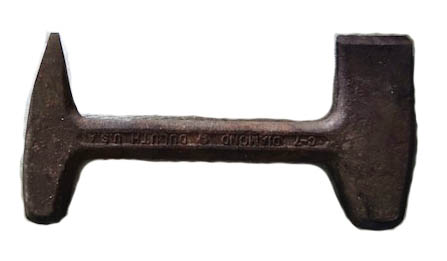
|
[Farrier Tool] A clinch cutter functions as a dual farrier's tool tool that has functions in removing nails and adjusting nail holes. The blade on the one side has a sharp chisel edge that is placed under a horseshoe nail clinch and hit with a hammer, cutting or bending out the clinch and allowing the nail to be removed with minimal damage to the hoof wall . The second tapered edge on the other side is used for cleaning or resizing nail holes in a horse's hoof. A long central bar connects the two sides.
Clip
[Equine Equipage] A clip is an extension, snug to the hoof on either side of the toe of a horseshoe to help keep the shoe in place
Clocker
[Horse Racing] A clocker is a race track official that times racing horses during their workouts.
Clubhouse Turn
[Horse Racing] The clubhouse turn is one of the four sections of an oval race track and is the first one that follows the initially run, straight homestretch section after the starting gate.
Cluck
[Rider Vocalization] Clucking is a single or series of click-like sounds made by a rider to urge the horse along. Some riders use a single cluck to indicate proceed at a walk and a double cluck to transition from a walk to a trot. These are generally augmented with other aids.
Clydesdale
[Equine Breed] Clydesdales are a breed of draft horse named for the county of Clydesdale in Scotland. They are commonly bay in color with significant white markings. Some mature males are taller than 18 hands at the withers and weigh up to 2,200 pounds. They tend to have a slightly convex facial profile, broad forehead, wide muzzle, an arched neck and are well muscled and strong. They are familiar to Americans as the draft horses of the Budweiser (brand of beer) Clydesdales of the Anheuser-Busch Brewing Company, which perform drawing a large red and gold wagon.
Coach
[Driving] A coach is a type of four wheel, four to six horse carriage with four posts and a fixed roof.
Coaching
[Driving Activity or Competition] Coaching describes the act of driving a coach or carriage, often in competition. It demands a high degree of skill to direct a team of multiple horses. In additional matching animals are often sought out and the vehicle and harness equipment is costly.
Cob
[Equine Characterization] A cob is a generic term for any small horse or large pony, under 5.3 hands in height, The term is little used today, but was applied to strong, utilitarian, saddle horses that were fully capable of carrying relatively heavy riders. When breeding horses it is never possible to predict that a foal will nature into a cob sized horse or not.
Cob
[Equine Equipage] Cob size is a term used as an indicator of smaller-sized bridles, halters and fly masks.
Coffee Housing
[Fox Chasing] Coffee housing is a pejorative term that the more serious fox chasers apply to those who would rather converse, particularly during more focal moments of the chase.
Coffin Bone
[Equine Anatomy] The Coffin bone is the distal phalanx of the 3rd digit of a horse and the principle bone of the hoof.
Coffin Jump
[Cross Country Jumping] A coffin jump is constructed with an open, revetted (supported) ditch, often having with post and rail fences in front of downward slopes on either side of the ditch.
Coggins Test
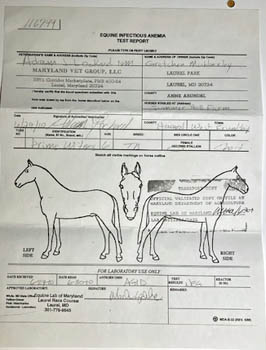
|
[Veterinary Medicne] A Coggins test is a blood test that detects antibodies to the causal organism of Equine Infectious Anemia (EIA). A current negative test result is often required to stable a horse at a new location, attend a horse show or transport a horse across state lines.
Cold-Backed
[Veterinary Medicine] A cold-backed horse reacts when being saddled or mounted, suggesting that it has back soreness.
Cold-Bloods
[Horse Breed Category] Cold-bloods are horse breeds, which have attributes of good temperament, strength and stamina but not speed. They tend to be stocky and easy keepers. Included in this category are draft and the various pony breeds. The term is used in contrast to other breeds considered hot-bloods or warm-bloods.
Colic
[Equine Veterinary Condition] A much-feared obstruction of the equine digestive system, which if left untreated may result in a horse's death. Colic has many causes and occurs at different levels of the digestive system but the end result is that there is an obstruction. The signs of colic are restlessness, frequent change of position with laying down and getting up, sweating, rapid pulse and respirations and looking toward the flanks. The pain the animal is experiencing is "colicky," which indicates that it comes in waves and is not a steady pain. When listening with a stethoscope (an owner should have one) the bowel sounds are often initially high-pitched and frequent. The total absence of any bowel sounds is ominous in a horse. If colic is suspected, it is imperative a veterinarian be promptly summoned for an emergency visit. Hospitalization in an equine medical center for rehydration and observation might be a consideration in milder cases. Colic is considered to be the leading cause of death in horses and an owner should have a plan in mind in the event to deal with it, should it occur. Do not delay acting. I am totally speaking from experience here and am not being an alarmist. This is really a very serious situation and not that all that rare. At the end of the day you should be able to say you did the right thing by your animal.
Collar
[Equine Equipage] Part of a harness fitted around the base of the neck that a horse pulls against.
Collection
[Equine Gaits] Collection is the act of a horse deliberately shortening the length that its steps during a particular gait. The gait is then referred to as a collected walk, collected trot, etc. This can be seen most graphically during dressage competitions. The opposite of collection is called extension. In most riding situations riders do not care how extended or collected their horses are.
Colors (Colours- British Usage)
[Fox Chasing] Various formal hunts have claimed colors to identify the hunter's affiliation. However, those can only be worn by hunt member, who are awarded the right by the master and only shown while in the field. The colors appear on the collar or occasionally as trim on the facings of the coat.
Colors (Jockey Silks)
[Racing] Jockey wear an outfit, including a helmet cover, that identifies the owner or stable of the horse they are riding. These designs in total composition must be unique and are registered with the Jockey Club in the U.S. or the British Horseracing Authority in Britain.
Colostrum
[Equine Physiology] Colostrum is a antibody-laden “first milk” produced by mares, within the first 24 hours after giving birth. It is critical for the foals heath to receive this. The term also applies to other mammalian species.
Colt

|
[Equine Status] A colt is a male horse that is younger than four years old and has not been castrated.
Combination Bit
[Equestrian Equipage] A combination bit functions as both a bit and a hackamore. It is used when a horse needs a bit that can apply pressure to multiple areas of the mouth and face simultaneously. They come in several different designs.
Combination Jump
[Equestrian Jumping] A combination jump is a series of two or three jumps set in a total distance of forty feet. If a fault occurs jumping the 2nd or 3rd element, the rider must return to the 1st element and re-jump them from the beginning.
Combined Training (Eventing)
[Equestrian Disciple and Competition] Combined Training consists of three riding disciplines of dressage, cross-country, and show jumping. The term is falling into disuse and is being replaced by the word eventing.
Comfort Zone
[Equine Behavior] A horse's comfort zone is the distance at which a horse is not alarmed by a potentially frightening environment entity (including another horse or person). It is useful for a rider to have a sense of a horse's comfort zone and to work with the horse to educate it regarding the true risk posed by the source of the fear.
Competitive Dressage
[Equestrian Discipline] Competitive dressage evolved from classical dressage. It is more practiced and assessable to ordinary riders. Many of the movements of classical dressage are omitted and the remaining ones are packaged into a individually performed dressage tests with ascending difficulty. Most areas in the U.S. have instruction in dressage available in indoor facilities that offer periodic judged dressage tests. Dressage is demanding and requires a pronounced degree of motivation from the rider and aptitude in the mount. As much as I admire dressage, I do not believe that either myself or, just as important my horse, could do it.
Competitive Trail Ride
[Equestrian Event] A competitive trail ride is a competition in which the riders ride a course, often 50 miles, trying to complete the course the closest to a predetermined optimum time. The differences between completive trail rides and a similar sport, endurance trail rides is that in endurance riding the courses tend to be longer and the winner is the first to reach the finish line.
Conformation
[Equine Attributes] A horse's conformation is their physical characteristics judged relative to the ideal standards of their particular breed. When shown in a conformation class and standing still the correctness of bone, musculature and proportions, as well as the degree of over-all refinement are rated by judges. When moving the horse is rated on its gaits and the nature of its movements.
Conformation Hunter
[Horse Showing] A conformation hunter class judges a horse both on conformation, as well as gaits under saddle and over fences. The major difference from a pure conformation class is that in a confirmation class the horse in led rather than under saddle.
Contact
[Rider's Attribute] There are two types of contact in riding. The first, being the degree of rein pressure against the horses mouth. A rider does not want to have too much or too little and an individual horse may need more or less contact. When riding a horse for the first time a rider need to get a feel for the horses response to pressure. Too much and the horse may back up or rebel. Too little and the rider lacks control. There should be no slack in the reins in most circumstances and there should be a straight line between the reins and the rider's elbow. Riders need to take up or back off the placement of their hands on the length of rein they are holding. When walking the rider should follow the horses movement, allowing for a slight back and forth motion. The second kind of contact is that of the rider's seat and the saddle. A rider at a posting trot or at a canter should not be bouncing around in the saddle but smoothly posting and almost gliding in their seat at the canter. When I observe novice riders during a horse show, I can get a feeling for their progress by the degree of contact they are exhibiting.
Connemara Pony
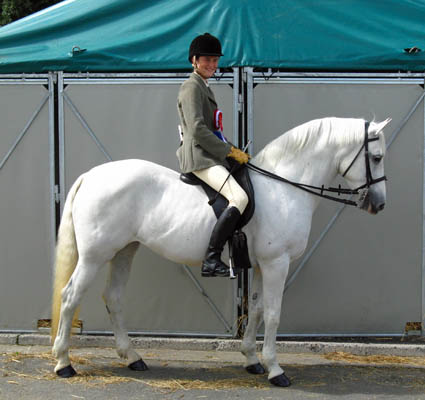
| 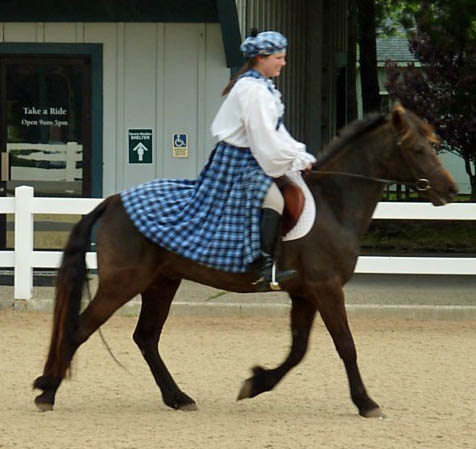
|
[Horse Breed] The Connemara Pony is native to the Connemara region in County Galway in western Ireland. They are considered good sport horses with refined features, strong bones, intelligence and good temperament.
Coop
[Jumping] A coop is a type of jump built of flat boards that slope from the center point on either side. The design is utilitarian on a hunt field in that it can cover a wife fence and create a save area to jump the fence.
Copper Snaffle Bit
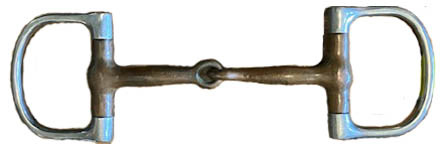
|
[Equine Equipage] A copper snaffle bit uses copper rather than stainless steel in the mouthpiece. It is believed that the copper encourages horses to salivate, relax their jaw and accept the bit easier.
Corn
[Veterinary Medicine] A corn is a bruising of the sole of a horse's hoof, most commonly seen in the insides of the front feet. It is a cause of lameness and results from faulty hoof conformation, excessive trimming or horse shoes that have remained too long on the feet and have resulted in overgrowth of the hoof. Interventions by a veterinarian or farrier depending on the specific cause is generally successful.
Coronary Band (also Coronet)
[Equine Anatomy] The area directly above the horse's hoof that is a ring of soft tissue that blends into the skin of the leg. The hoof wall grows from this point. An abscess in the hoof will often break out there.
Corkscrew Bit
[Equine Equipage] A type of snaffle bit with twists in the mouthpiece that provides increased control over a strong horse, but is rather severe and should be used judiciously.
Corpora Nigra
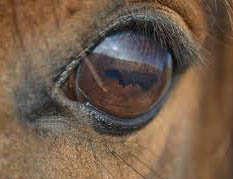
|
[Equine Anatomy] The corpora nigra is a naturally occurring, elongated, dark body located in the anterior chamber of a horse's eye that shade the pupil from glare. The word is Latin for dark body. Cysts can develop rarely within the corpora nigra but otherwise their presence is a normal anatomical feature.
Counter Canter
[Equestrian Gait] A counter canter is a canter in which the horse is on the incorrect lead while moving in a circle. This may be done deliberately in certain dressage exercises or in polo in certain situations.
Coupé
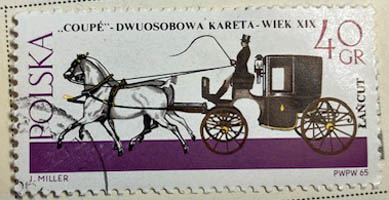
|
[Carriage Type] A coupé is a short, four-wheeled, closed carriage. It generally had two passengers and an outside driver.
Couple
[Fox Chasing] Hounds are always counted in couples of two hounds. A tradition says that an extra half couple (a single hound) is the one who will find the fox.
Courbette
[Classical Dressage] A courbette is a movement in which the horse performs a series of jumps on the hind legs without the forelegs touching the ground. It is one of the "airs above the ground" that can be seen at demonstrations of the Spanish Riding School of Vienna. The horse requires a great deal of body strength, training and conditioning to execute the movement. The viewer's general impression is that the horse is hopping.
Courtesy Fence
[Jumping] Riders who fall on when taking a jump in a horse show were allowed by the judge to remount and repeat the jump as a courtesy fence. I still see this being done, but it is becoming less common. I think it is justified when novice riders are jumping in order to maintain a level of confidence in their ability to master a jump, provided that they are safe to proceed.
Cover
[Horse Breeding] Cover is the act of the breeding of a mare by a stallion by natural means.
Covert
[Fox Chasing] This word is pronounced as cover. A covert is a place that a fox might find cover. It may be woods, brush, rocks, etc. Foxes seek a hiding place when they become aware of a threat in the environment. These areas are known to the huntsman who hopes the hounds will pick a scent (line).
Cow Kick
[Equine Behavior] A cow kick is a form of equine kick in which the rear leg is initially draw up and the kick is delivered outward and to the side in a circular motion. When standing beside a horse grooming them you should be very careful if you notice them raising their back leg and they have their ears plastered back. A cow kick might follow (perhaps even one you deserve). The more common kick is to the rear with the legs fully extended. A horse prone to cow kicking is a problem on the hunt field and is likely be sent home before the end of the hunt.
Cow Sense
[Horse Attribute] In ranching or rodeo work the innate ability of a cutting, reining or roping horse to sense the next move of a steer.
Coxitis
[Veterinary Medicine] Coxitis is an inflammatory condition of the coxofemoral articulation (joint between the upper leg and the hip). It results from trauma and produces lameness. In the most serious cases a fracture of the acetabulum (cup-shaped socket of the hip joint) has occurred. It can be associated with systemic infection. Veterinary consultation is required in all suspected cases and the prognosis is usually poor.
Crest Release
[Equine Jumping] The crest release is a jumping technique in which the rider grabs the horse's mane with their hands for support and releases any pressure on the horse mouth by the reins. It keeps the rider from jerking the horses mouth with the bit. It is particularly useful for beginner and intermediate riders, but even some veteran riders prefer it. If your watching a person jump and the reins have some slack in them they are likely using a crest release. In both crest release and the other release type, called the automatic release, the hands are at the mane, the difference being that with the automatic release the rider is gliding along the mane and not holding on it. The crest technique has two variations: long and short, but that is a more advanced concern. I remember when I was first learning to jump my instructor had me use the crest release. I found it useful in that it allowed me not to worry about jerking the mouth. When jumping things happens fast and takes a lot of coordination to get it all done right. In both techniques the goal is to momentarily break firm contact with the mouth when the horse is extending its neck to jump. This is why the word release is used. It is a matter of timing and preserving contact and control when the jump is completed. With the automatic release regaining contact is not a big issue. However, regaining proper contact is a big issue for those using the crest release. It is a form of a trade off. The crest release is easy at the beginning of the jump, but can make for more challenges in the aftermath. There is much more to jumping than just the hand release technique and people think the horse is doing all the work.
Cribbing (Crib Biting)
[Equine Behavior] Cribbing is a vice among horses in which the horse repetitively grabs a stationary object in its front teeth, arches its neck and makes a sound resembling a burp.
Cricket Clicker
[Training Device] This is a small hand held device that creates a sharp distinctive click sound. It can be used to condition a horse to do a specific behavior the user wishes.
Criollo (Crioulo)
[Horse Breed] Criollos are native to the the Pampas region of Argentina, Brazil and Peru. They are small, strong, mostly dun-colored horses used for ranch and pack work. They are easy keepers and have much endurance.
Crossing the Line
[Polo] Crossing the line is the most frequent foul occurring in polo play. The direction that the ball is traveling in defines an imaginary line, known as the line of the ball and a right of way afforded the nearest player. An opponent who crosses the line has committed this foul. The team that has been fouled gets a free hit from a set distance.
Crossrails (Cross Pole Jump)
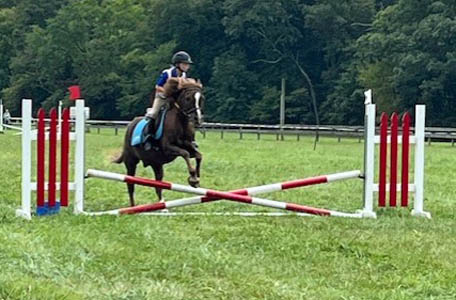
|
[Jumping] When the rails of a jump are placed so that they cross in an "X" the jump is said to have crossrails.
Cross Sabers
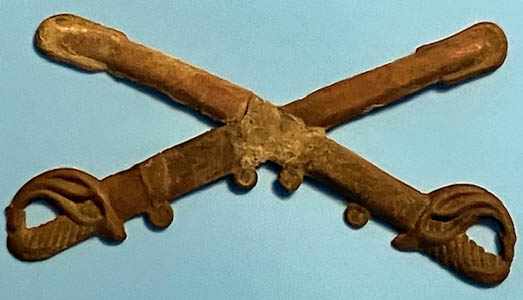
|
[Cavalry Insignia] Crossed sabers are a traditional military insignia used by many of the world's armies, including the United States. Horse cavalry disappeared from the U.S. Regular Army in 1942 when cavalry units were repurposed.
Cross Tie
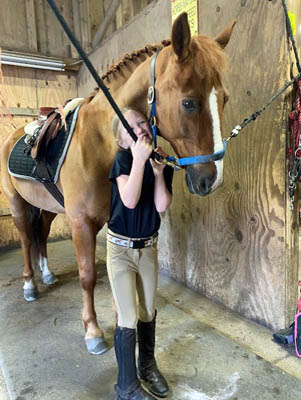
|
[Horse Management] Many riders use cross ties when readying a horse to ride, shoeing, veterinary procedures or in a wash stall. Cross ties are a pair of lines, firmly attached to a wall or beam on one side and attached to the horse's halter by a snap on the other. They compel the horse to stand still in a restricted area while they are being worked on. They are commonly set up in stalls or breezeways. When a horse is cross tied the rider or profession can concentrate on what they need to do without the horse moving all around. However, one problem is that the horse has problems dealing with flies in warm weather. Cross tying needs to be careful introduced to a green horse and should never be done to horse under two until they are more used to being handled and tied. Myself, I have never cross tied any of my own horses and there are those horse experts that condemn the practice for various reasons. For example, a well-trained horse should know to stand still. Hitching posts that attach only on one side and ground tying are alternatives.
Croup
[Equine Anatomy] The croup describes the region of a horse's back running from the lumbosacral joint to the tail. When viewed from the side the area is elevated relative the lowest point of the back and should be about the same height as the withers.
Crupper
[Horse Equipage] A strap that is buckled to the back of the saddle and runs down the back of the horse to loop around the tail. Its function is to prevent the saddle from slipping forward, particularly when riding downhill. Cruppers are also used in driving to prevent parts of the harness from slipping forward.
Cry
[Fox Chasing] A pack of fox hound communicate with each other and are understood by the huntsman by a series of distinctive sounds known as cries they emit during the hunt. The bond between hunter and hound is truly ancient, but most of us now have never heard the language spoken.
Cubbing (Cub Hunting- British Usage)
[Fox Chasing] Hunts begin cubbing about 2 months prior to the opening of hunt season. It is a period when newly entered (inexperienced) hounds are trained to run in a pack and follow commands of the staff. Members of the hunt may accompany the activity but the dress is less formal. Cubbing not only trains the hounds but it also educates younger foxes how to avoid being caught in the open. Prior to cubbing the hunt staff will exercise hounds to condition them.
Cuirass
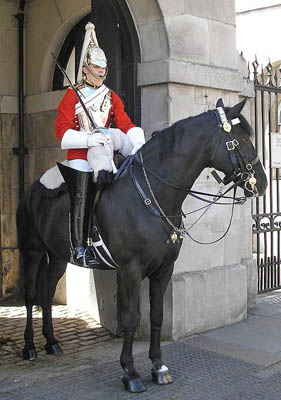
|
[Military Equipage] A cuirass is piece of armor that covers the front and back of the torso of a soldier, often burnished to a high sheen. It was a mark of heavy cavalry units in the European armies. Many heavy cavalry regiments were named as cuirassiers. The cuirass would be unlikely to stop a bullet but it might have deflected a saber or a lance. The cuirass is still worn as a part of the dress of the British Household Cavalry Regiments.
Cups (Infundibulum)

|
[Equine Dentition] Cups are a hollow area on the grinding surface of the incisors formed by the natural infolding of the enamel, wear and replacement of the pulp with dentin. They are a dark brown color relative to surrounding tooth. As the teeth wear and the horse ages, cups will typically disappear at about age 9.
Curb
[Veterinary Medicine] Curb is the descriptive term for various inflammatory conditions leading to a swelling in the rear of the leg just above the point of the hock. These are the result of various soft tissue injuries of the distal plantar hock region. Often a thickening or bowing of the plantar tarsal ligament is discovered. A more specific diagnosis can be established by ultrasound. These are a result of traumatic injuries and result in lameness.
Curb Bit
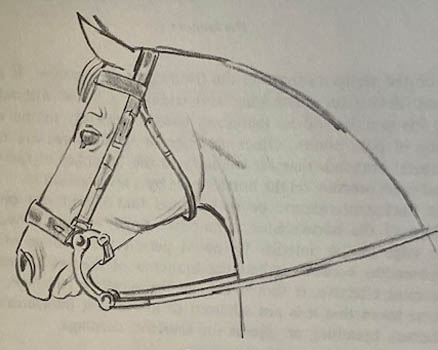
|
[Equine Equipage] A curb bit is a leverage bit worked with a single rein. The mouth piece may or may not be hinged and attaches to a pair of shanks on either side. These shanks are metal pieces that extend to a pair of rings on either end. One set is attached to the reins and on the other end of the shank are rings that attach to the headstall. The level action is provided by the separation. In addition, a curb chain or leather strap passes under the horse's chin and provides additional pressure. Most classical Western bits are of this type. When viewing a horse with any kind of leverage bit you have the impression that parts of the bit are hanging down from the horse's mouth when the rider has the reins loose. When the reins are pulled back you see the shanks rotate upwards. With a snaffle type non-leverage bit you see only the single ring at the mouth. There are hybrids that have both a curb and snaffle features.
Curry
[Horse Care] Horses are curried as a part of the act of grooming or cleaning their coats. This is the initial step to remove dirt and even break up mud on the coat. It is commonly done with a rubber curry comb, although medal ones exist also. In a circular fashion the comb is pulled thought the coat in short strokes in the direction of the hairs. Periodically dirt should be removed from the comb.
Curry Comb
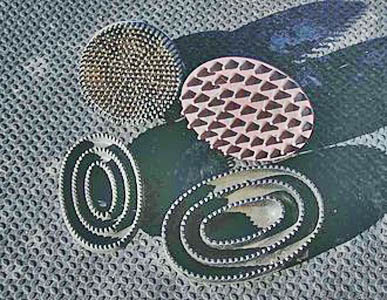
|
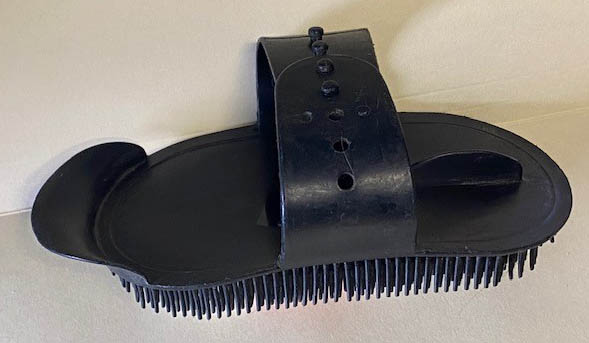
|
[Horse Care] A grooming implement used to curry a horse's coat. There are multiple types.
Cushing's Disease in Horses (Pituitary pars intermedia dysfunction or PPID)
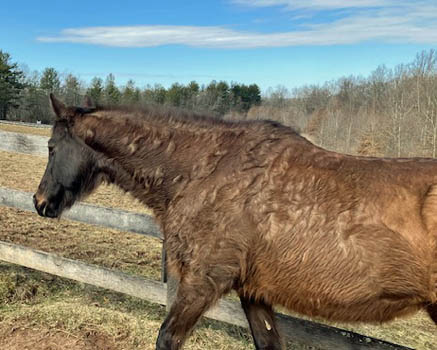
|
[Veterinary Medicine] Cushing's Disease in horses is techinally called Equine Pituitary Pars Intermedia Dysfunction (PPID). The term is used in human medicine for a similar condition that has a different mechanism. In horses an area of the pituitary gland escapes inhibition, increases in size forming a benign tumor and overproduces various hormones, such as Adrenocorticotropic hormone (ACTH) and Alpha-Melanocyte-Stimulating Hormone (α-MSH). Most of the symptoms of Cushing's are the result higher levels of the hormone cortisol, which ACTH triggers the adrenal glands to manufacture. Perhaps, the earliest sign is a increased thirst and urination. The animal will wish to take a drink at every water source it encounters. When grooming the horse the groom will notice changes in the coat. These changes include longer, more curtly and oily hair and a delay in loss of the winter coat. The horse is at greater risk of laminitis, has depressed immune function, has a decrease in energy and muscle mass. Cushing's is a disease of older horses and one option is the retire the horse without any aggressive treatment. The drug bromocriptine is effective but must be given subcutaneously. Another drug pergolide meslyate is very effective but its recent recall for use in human medicine is adversely effecting its availability for veterinary use.
Cutting Horse
[Equine Employment] A Cutting horse is a specially trained horse used in cattle herding. They are for the most part of the Quarter Horse breed. A cutting horse is capable of cutting a specific steer out of a herd. Steers, beginning herd animals, want to be within their herd and resist being cut out. A cutting horse anticipates the movement of the steer (called cow sense) and blocks it. The rider indicates to the horse which steer is the target but afterwards it is the horse itself that is determining its movements not the rider. The rider's only challenge is to follow the movements of the horse and retain his balance. A cutting horse is the equine equivalent to a sheep dog. Its is quite impressive if you closely follow what his happening during a cut. The practical use of a horse cutting for the most part is no longer needed in ranching but the tradition is retained in rodeo events.